Detailed Report: Risk Financing and Insurance for Ocean Cuisine PLC
VerifiedAdded on 2020/01/28
|8
|2812
|387
Report
AI Summary
This report analyzes risk financing and insurance, focusing on a case study of Ocean Cuisine PLC and its employee stock option plan. The report details the determinants of decision-making regarding option exercising, assessing both minimum and maximum values under different scenarios. It then explores the pros and cons of hedging strategies employed by airline companies to manage fuel costs, examining the use of derivative instruments like futures, options, swaps, and interest rate derivatives. The report highlights the benefits of these instruments, such as cost management, flexibility, and risk mitigation, while also addressing potential drawbacks like legal obligations, imperfect hedging, and complexity. The conclusion summarizes the key findings and implications for financial risk management.

Risk Financing and
Insurance
1
Insurance
1
Paraphrase This Document
Need a fresh take? Get an instant paraphrase of this document with our AI Paraphraser
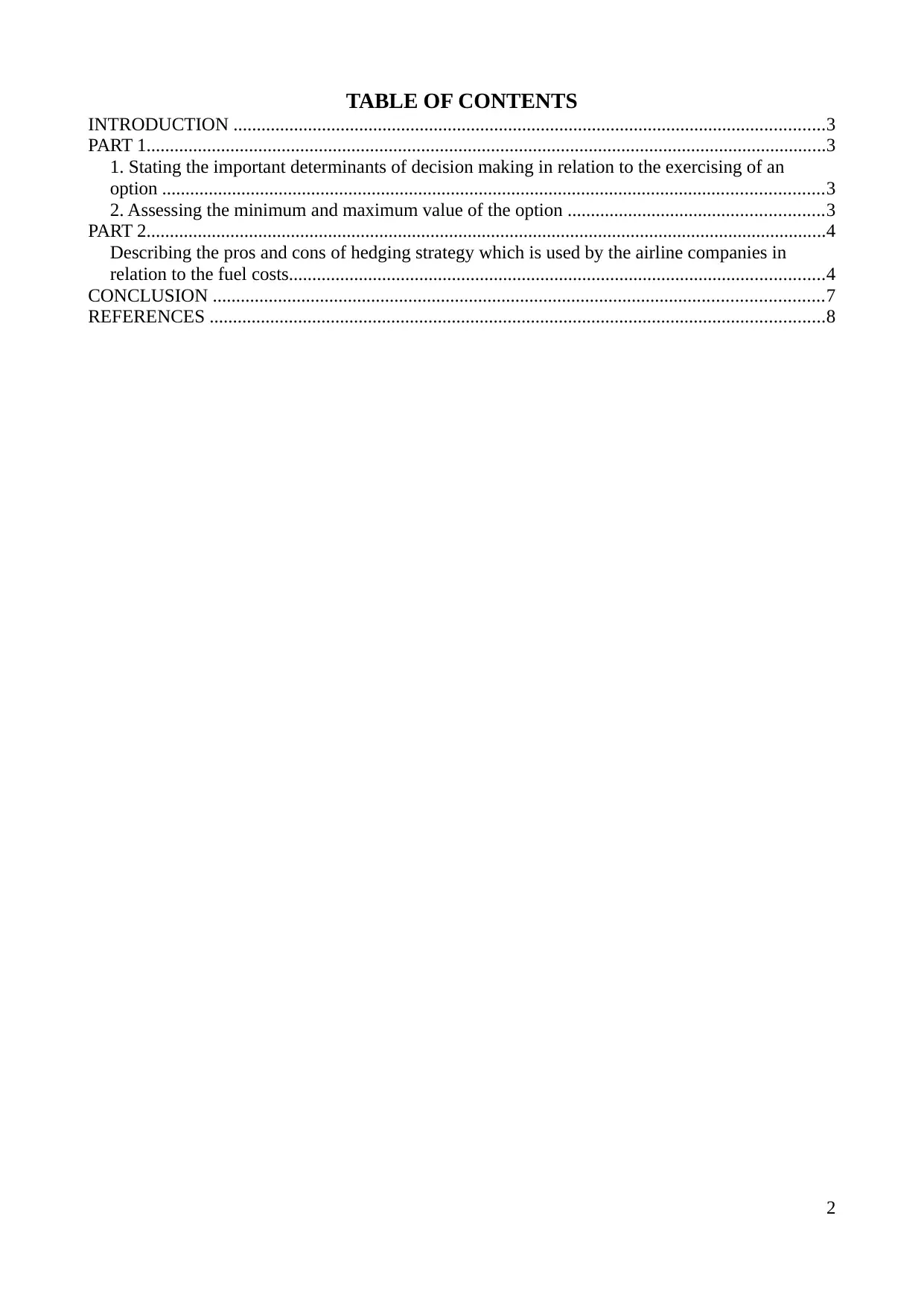
TABLE OF CONTENTS
INTRODUCTION ...............................................................................................................................3
PART 1..................................................................................................................................................3
1. Stating the important determinants of decision making in relation to the exercising of an
option ..............................................................................................................................................3
2. Assessing the minimum and maximum value of the option .......................................................3
PART 2..................................................................................................................................................4
Describing the pros and cons of hedging strategy which is used by the airline companies in
relation to the fuel costs...................................................................................................................4
CONCLUSION ...................................................................................................................................7
REFERENCES ....................................................................................................................................8
2
INTRODUCTION ...............................................................................................................................3
PART 1..................................................................................................................................................3
1. Stating the important determinants of decision making in relation to the exercising of an
option ..............................................................................................................................................3
2. Assessing the minimum and maximum value of the option .......................................................3
PART 2..................................................................................................................................................4
Describing the pros and cons of hedging strategy which is used by the airline companies in
relation to the fuel costs...................................................................................................................4
CONCLUSION ...................................................................................................................................7
REFERENCES ....................................................................................................................................8
2
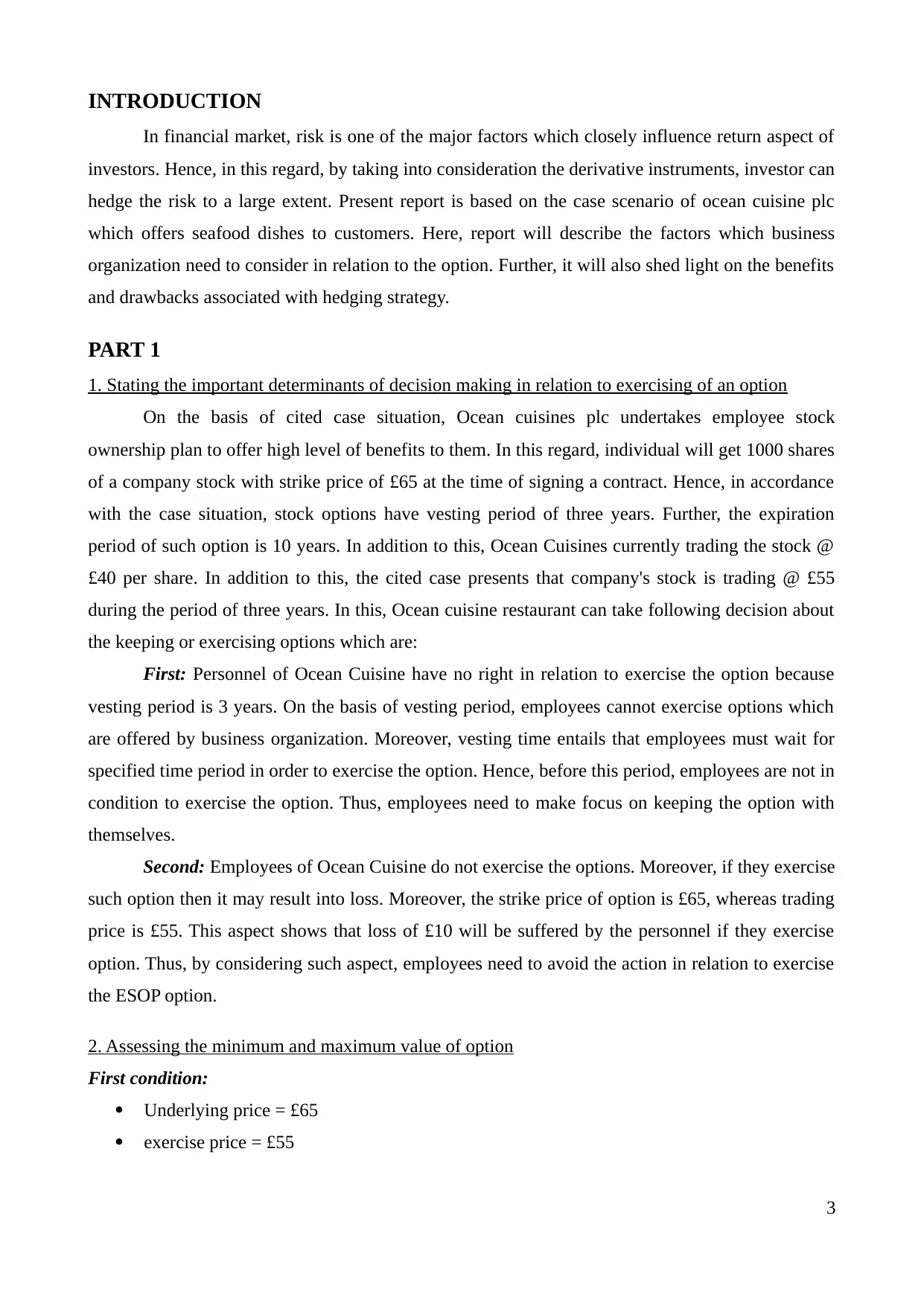
INTRODUCTION
In financial market, risk is one of the major factors which closely influence return aspect of
investors. Hence, in this regard, by taking into consideration the derivative instruments, investor can
hedge the risk to a large extent. Present report is based on the case scenario of ocean cuisine plc
which offers seafood dishes to customers. Here, report will describe the factors which business
organization need to consider in relation to the option. Further, it will also shed light on the benefits
and drawbacks associated with hedging strategy.
PART 1
1. Stating the important determinants of decision making in relation to exercising of an option
On the basis of cited case situation, Ocean cuisines plc undertakes employee stock
ownership plan to offer high level of benefits to them. In this regard, individual will get 1000 shares
of a company stock with strike price of £65 at the time of signing a contract. Hence, in accordance
with the case situation, stock options have vesting period of three years. Further, the expiration
period of such option is 10 years. In addition to this, Ocean Cuisines currently trading the stock @
£40 per share. In addition to this, the cited case presents that company's stock is trading @ £55
during the period of three years. In this, Ocean cuisine restaurant can take following decision about
the keeping or exercising options which are:
First: Personnel of Ocean Cuisine have no right in relation to exercise the option because
vesting period is 3 years. On the basis of vesting period, employees cannot exercise options which
are offered by business organization. Moreover, vesting time entails that employees must wait for
specified time period in order to exercise the option. Hence, before this period, employees are not in
condition to exercise the option. Thus, employees need to make focus on keeping the option with
themselves.
Second: Employees of Ocean Cuisine do not exercise the options. Moreover, if they exercise
such option then it may result into loss. Moreover, the strike price of option is £65, whereas trading
price is £55. This aspect shows that loss of £10 will be suffered by the personnel if they exercise
option. Thus, by considering such aspect, employees need to avoid the action in relation to exercise
the ESOP option.
2. Assessing the minimum and maximum value of option
First condition:
Underlying price = £65
exercise price = £55
3
In financial market, risk is one of the major factors which closely influence return aspect of
investors. Hence, in this regard, by taking into consideration the derivative instruments, investor can
hedge the risk to a large extent. Present report is based on the case scenario of ocean cuisine plc
which offers seafood dishes to customers. Here, report will describe the factors which business
organization need to consider in relation to the option. Further, it will also shed light on the benefits
and drawbacks associated with hedging strategy.
PART 1
1. Stating the important determinants of decision making in relation to exercising of an option
On the basis of cited case situation, Ocean cuisines plc undertakes employee stock
ownership plan to offer high level of benefits to them. In this regard, individual will get 1000 shares
of a company stock with strike price of £65 at the time of signing a contract. Hence, in accordance
with the case situation, stock options have vesting period of three years. Further, the expiration
period of such option is 10 years. In addition to this, Ocean Cuisines currently trading the stock @
£40 per share. In addition to this, the cited case presents that company's stock is trading @ £55
during the period of three years. In this, Ocean cuisine restaurant can take following decision about
the keeping or exercising options which are:
First: Personnel of Ocean Cuisine have no right in relation to exercise the option because
vesting period is 3 years. On the basis of vesting period, employees cannot exercise options which
are offered by business organization. Moreover, vesting time entails that employees must wait for
specified time period in order to exercise the option. Hence, before this period, employees are not in
condition to exercise the option. Thus, employees need to make focus on keeping the option with
themselves.
Second: Employees of Ocean Cuisine do not exercise the options. Moreover, if they exercise
such option then it may result into loss. Moreover, the strike price of option is £65, whereas trading
price is £55. This aspect shows that loss of £10 will be suffered by the personnel if they exercise
option. Thus, by considering such aspect, employees need to avoid the action in relation to exercise
the ESOP option.
2. Assessing the minimum and maximum value of option
First condition:
Underlying price = £65
exercise price = £55
3
⊘ This is a preview!⊘
Do you want full access?
Subscribe today to unlock all pages.

Trusted by 1+ million students worldwide
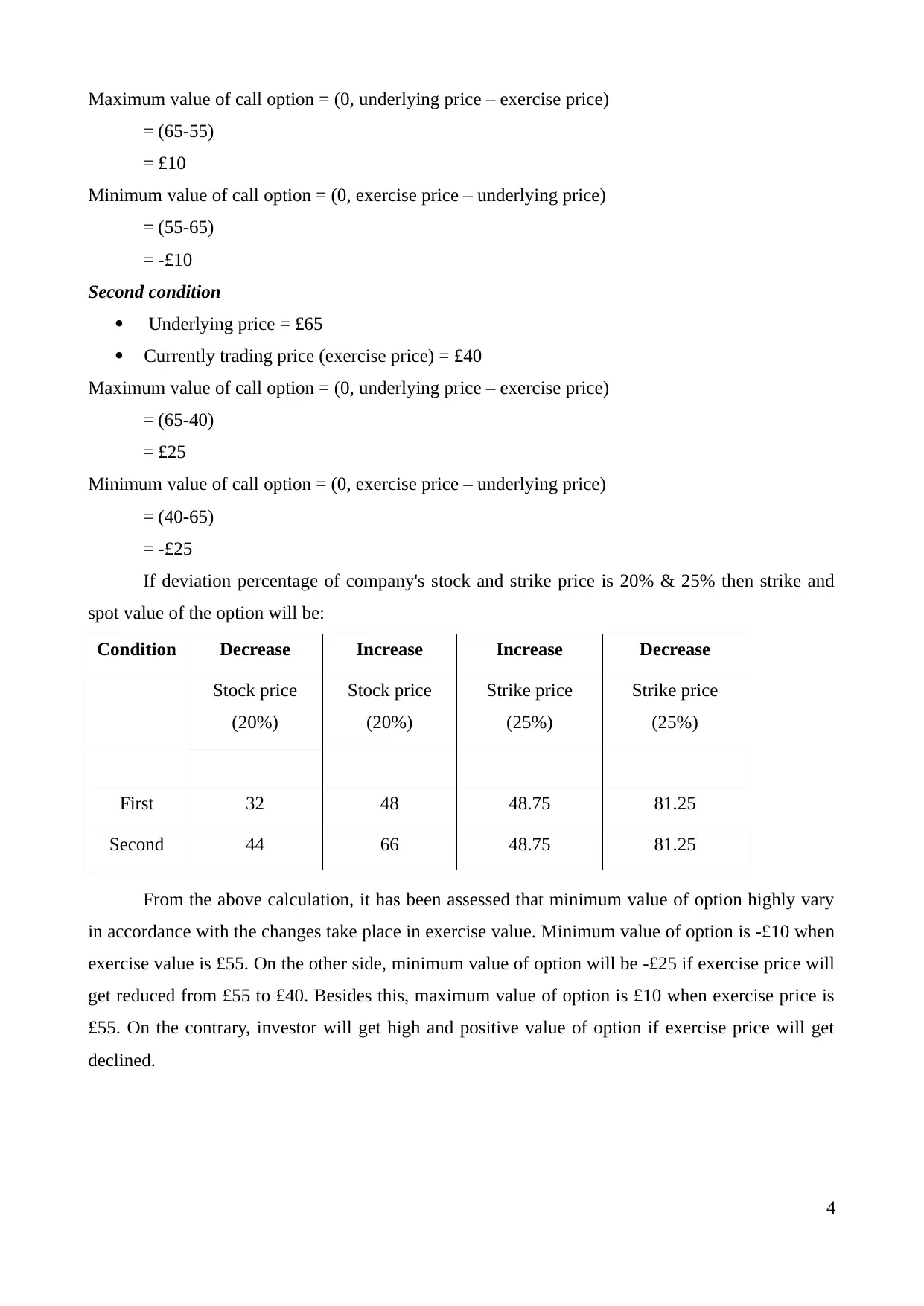
Maximum value of call option = (0, underlying price – exercise price)
= (65-55)
= £10
Minimum value of call option = (0, exercise price – underlying price)
= (55-65)
= -£10
Second condition
Underlying price = £65
Currently trading price (exercise price) = £40
Maximum value of call option = (0, underlying price – exercise price)
= (65-40)
= £25
Minimum value of call option = (0, exercise price – underlying price)
= (40-65)
= -£25
If deviation percentage of company's stock and strike price is 20% & 25% then strike and
spot value of the option will be:
Condition Decrease Increase Increase Decrease
Stock price
(20%)
Stock price
(20%)
Strike price
(25%)
Strike price
(25%)
First 32 48 48.75 81.25
Second 44 66 48.75 81.25
From the above calculation, it has been assessed that minimum value of option highly vary
in accordance with the changes take place in exercise value. Minimum value of option is -£10 when
exercise value is £55. On the other side, minimum value of option will be -£25 if exercise price will
get reduced from £55 to £40. Besides this, maximum value of option is £10 when exercise price is
£55. On the contrary, investor will get high and positive value of option if exercise price will get
declined.
4
= (65-55)
= £10
Minimum value of call option = (0, exercise price – underlying price)
= (55-65)
= -£10
Second condition
Underlying price = £65
Currently trading price (exercise price) = £40
Maximum value of call option = (0, underlying price – exercise price)
= (65-40)
= £25
Minimum value of call option = (0, exercise price – underlying price)
= (40-65)
= -£25
If deviation percentage of company's stock and strike price is 20% & 25% then strike and
spot value of the option will be:
Condition Decrease Increase Increase Decrease
Stock price
(20%)
Stock price
(20%)
Strike price
(25%)
Strike price
(25%)
First 32 48 48.75 81.25
Second 44 66 48.75 81.25
From the above calculation, it has been assessed that minimum value of option highly vary
in accordance with the changes take place in exercise value. Minimum value of option is -£10 when
exercise value is £55. On the other side, minimum value of option will be -£25 if exercise price will
get reduced from £55 to £40. Besides this, maximum value of option is £10 when exercise price is
£55. On the contrary, investor will get high and positive value of option if exercise price will get
declined.
4
Paraphrase This Document
Need a fresh take? Get an instant paraphrase of this document with our AI Paraphraser
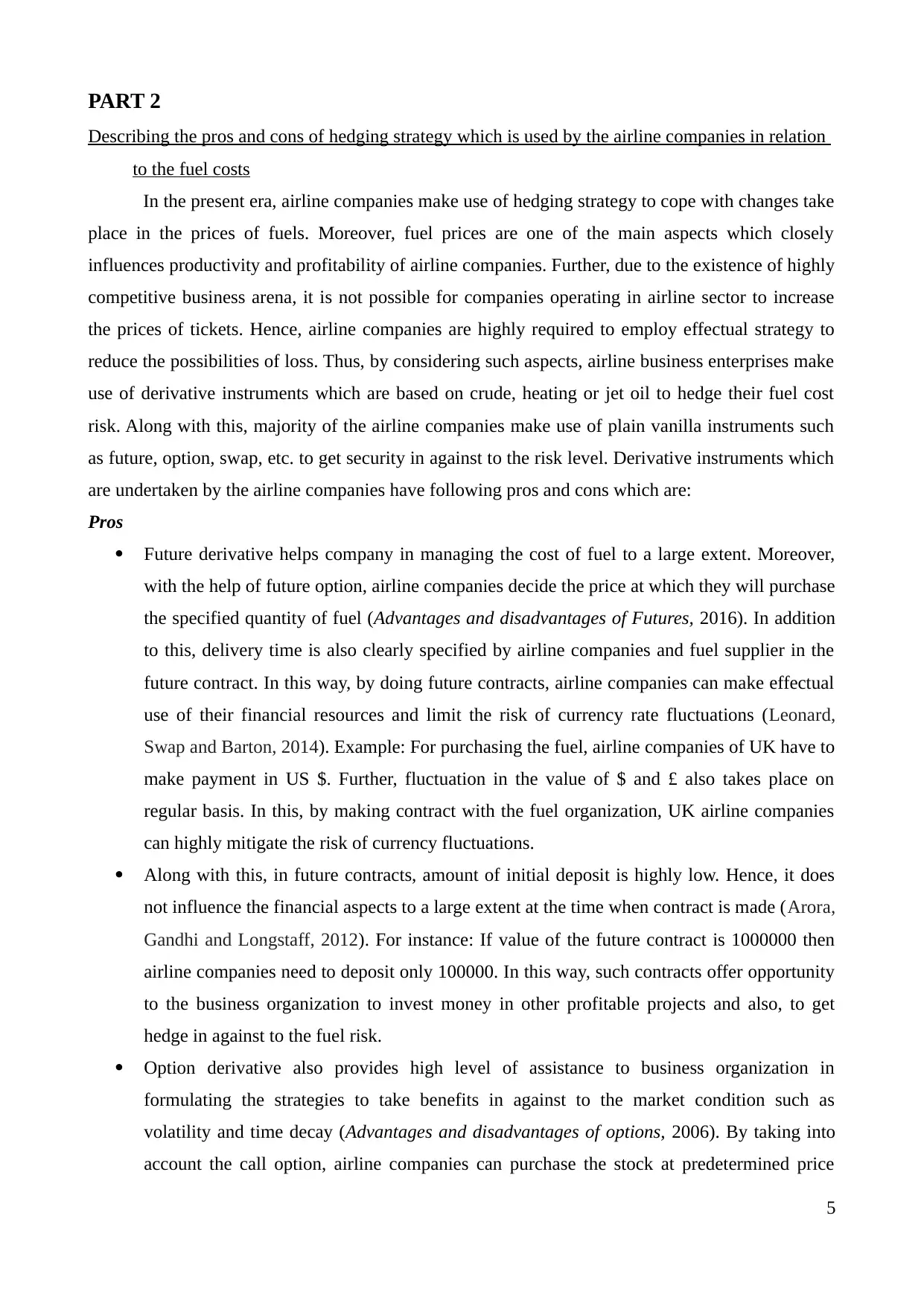
PART 2
Describing the pros and cons of hedging strategy which is used by the airline companies in relation
to the fuel costs
In the present era, airline companies make use of hedging strategy to cope with changes take
place in the prices of fuels. Moreover, fuel prices are one of the main aspects which closely
influences productivity and profitability of airline companies. Further, due to the existence of highly
competitive business arena, it is not possible for companies operating in airline sector to increase
the prices of tickets. Hence, airline companies are highly required to employ effectual strategy to
reduce the possibilities of loss. Thus, by considering such aspects, airline business enterprises make
use of derivative instruments which are based on crude, heating or jet oil to hedge their fuel cost
risk. Along with this, majority of the airline companies make use of plain vanilla instruments such
as future, option, swap, etc. to get security in against to the risk level. Derivative instruments which
are undertaken by the airline companies have following pros and cons which are:
Pros
Future derivative helps company in managing the cost of fuel to a large extent. Moreover,
with the help of future option, airline companies decide the price at which they will purchase
the specified quantity of fuel (Advantages and disadvantages of Futures, 2016). In addition
to this, delivery time is also clearly specified by airline companies and fuel supplier in the
future contract. In this way, by doing future contracts, airline companies can make effectual
use of their financial resources and limit the risk of currency rate fluctuations (Leonard,
Swap and Barton, 2014). Example: For purchasing the fuel, airline companies of UK have to
make payment in US $. Further, fluctuation in the value of $ and £ also takes place on
regular basis. In this, by making contract with the fuel organization, UK airline companies
can highly mitigate the risk of currency fluctuations.
Along with this, in future contracts, amount of initial deposit is highly low. Hence, it does
not influence the financial aspects to a large extent at the time when contract is made (Arora,
Gandhi and Longstaff, 2012). For instance: If value of the future contract is 1000000 then
airline companies need to deposit only 100000. In this way, such contracts offer opportunity
to the business organization to invest money in other profitable projects and also, to get
hedge in against to the fuel risk.
Option derivative also provides high level of assistance to business organization in
formulating the strategies to take benefits in against to the market condition such as
volatility and time decay (Advantages and disadvantages of options, 2006). By taking into
account the call option, airline companies can purchase the stock at predetermined price
5
Describing the pros and cons of hedging strategy which is used by the airline companies in relation
to the fuel costs
In the present era, airline companies make use of hedging strategy to cope with changes take
place in the prices of fuels. Moreover, fuel prices are one of the main aspects which closely
influences productivity and profitability of airline companies. Further, due to the existence of highly
competitive business arena, it is not possible for companies operating in airline sector to increase
the prices of tickets. Hence, airline companies are highly required to employ effectual strategy to
reduce the possibilities of loss. Thus, by considering such aspects, airline business enterprises make
use of derivative instruments which are based on crude, heating or jet oil to hedge their fuel cost
risk. Along with this, majority of the airline companies make use of plain vanilla instruments such
as future, option, swap, etc. to get security in against to the risk level. Derivative instruments which
are undertaken by the airline companies have following pros and cons which are:
Pros
Future derivative helps company in managing the cost of fuel to a large extent. Moreover,
with the help of future option, airline companies decide the price at which they will purchase
the specified quantity of fuel (Advantages and disadvantages of Futures, 2016). In addition
to this, delivery time is also clearly specified by airline companies and fuel supplier in the
future contract. In this way, by doing future contracts, airline companies can make effectual
use of their financial resources and limit the risk of currency rate fluctuations (Leonard,
Swap and Barton, 2014). Example: For purchasing the fuel, airline companies of UK have to
make payment in US $. Further, fluctuation in the value of $ and £ also takes place on
regular basis. In this, by making contract with the fuel organization, UK airline companies
can highly mitigate the risk of currency fluctuations.
Along with this, in future contracts, amount of initial deposit is highly low. Hence, it does
not influence the financial aspects to a large extent at the time when contract is made (Arora,
Gandhi and Longstaff, 2012). For instance: If value of the future contract is 1000000 then
airline companies need to deposit only 100000. In this way, such contracts offer opportunity
to the business organization to invest money in other profitable projects and also, to get
hedge in against to the fuel risk.
Option derivative also provides high level of assistance to business organization in
formulating the strategies to take benefits in against to the market condition such as
volatility and time decay (Advantages and disadvantages of options, 2006). By taking into
account the call option, airline companies can purchase the stock at predetermined price
5
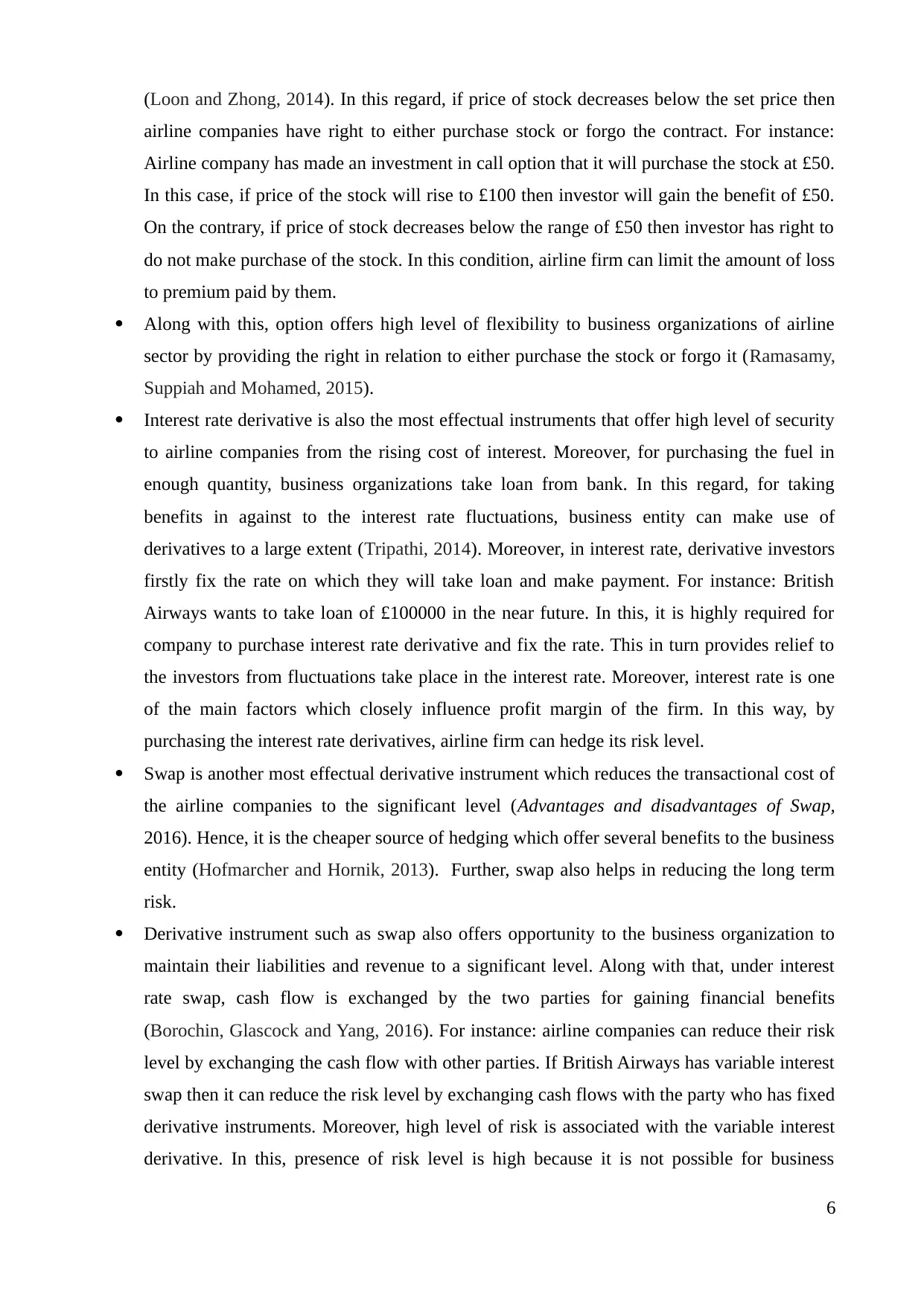
(Loon and Zhong, 2014). In this regard, if price of stock decreases below the set price then
airline companies have right to either purchase stock or forgo the contract. For instance:
Airline company has made an investment in call option that it will purchase the stock at £50.
In this case, if price of the stock will rise to £100 then investor will gain the benefit of £50.
On the contrary, if price of stock decreases below the range of £50 then investor has right to
do not make purchase of the stock. In this condition, airline firm can limit the amount of loss
to premium paid by them.
Along with this, option offers high level of flexibility to business organizations of airline
sector by providing the right in relation to either purchase the stock or forgo it (Ramasamy,
Suppiah and Mohamed, 2015).
Interest rate derivative is also the most effectual instruments that offer high level of security
to airline companies from the rising cost of interest. Moreover, for purchasing the fuel in
enough quantity, business organizations take loan from bank. In this regard, for taking
benefits in against to the interest rate fluctuations, business entity can make use of
derivatives to a large extent (Tripathi, 2014). Moreover, in interest rate, derivative investors
firstly fix the rate on which they will take loan and make payment. For instance: British
Airways wants to take loan of £100000 in the near future. In this, it is highly required for
company to purchase interest rate derivative and fix the rate. This in turn provides relief to
the investors from fluctuations take place in the interest rate. Moreover, interest rate is one
of the main factors which closely influence profit margin of the firm. In this way, by
purchasing the interest rate derivatives, airline firm can hedge its risk level.
Swap is another most effectual derivative instrument which reduces the transactional cost of
the airline companies to the significant level (Advantages and disadvantages of Swap,
2016). Hence, it is the cheaper source of hedging which offer several benefits to the business
entity (Hofmarcher and Hornik, 2013). Further, swap also helps in reducing the long term
risk.
Derivative instrument such as swap also offers opportunity to the business organization to
maintain their liabilities and revenue to a significant level. Along with that, under interest
rate swap, cash flow is exchanged by the two parties for gaining financial benefits
(Borochin, Glascock and Yang, 2016). For instance: airline companies can reduce their risk
level by exchanging the cash flow with other parties. If British Airways has variable interest
swap then it can reduce the risk level by exchanging cash flows with the party who has fixed
derivative instruments. Moreover, high level of risk is associated with the variable interest
derivative. In this, presence of risk level is high because it is not possible for business
6
airline companies have right to either purchase stock or forgo the contract. For instance:
Airline company has made an investment in call option that it will purchase the stock at £50.
In this case, if price of the stock will rise to £100 then investor will gain the benefit of £50.
On the contrary, if price of stock decreases below the range of £50 then investor has right to
do not make purchase of the stock. In this condition, airline firm can limit the amount of loss
to premium paid by them.
Along with this, option offers high level of flexibility to business organizations of airline
sector by providing the right in relation to either purchase the stock or forgo it (Ramasamy,
Suppiah and Mohamed, 2015).
Interest rate derivative is also the most effectual instruments that offer high level of security
to airline companies from the rising cost of interest. Moreover, for purchasing the fuel in
enough quantity, business organizations take loan from bank. In this regard, for taking
benefits in against to the interest rate fluctuations, business entity can make use of
derivatives to a large extent (Tripathi, 2014). Moreover, in interest rate, derivative investors
firstly fix the rate on which they will take loan and make payment. For instance: British
Airways wants to take loan of £100000 in the near future. In this, it is highly required for
company to purchase interest rate derivative and fix the rate. This in turn provides relief to
the investors from fluctuations take place in the interest rate. Moreover, interest rate is one
of the main factors which closely influence profit margin of the firm. In this way, by
purchasing the interest rate derivatives, airline firm can hedge its risk level.
Swap is another most effectual derivative instrument which reduces the transactional cost of
the airline companies to the significant level (Advantages and disadvantages of Swap,
2016). Hence, it is the cheaper source of hedging which offer several benefits to the business
entity (Hofmarcher and Hornik, 2013). Further, swap also helps in reducing the long term
risk.
Derivative instrument such as swap also offers opportunity to the business organization to
maintain their liabilities and revenue to a significant level. Along with that, under interest
rate swap, cash flow is exchanged by the two parties for gaining financial benefits
(Borochin, Glascock and Yang, 2016). For instance: airline companies can reduce their risk
level by exchanging the cash flow with other parties. If British Airways has variable interest
swap then it can reduce the risk level by exchanging cash flows with the party who has fixed
derivative instruments. Moreover, high level of risk is associated with the variable interest
derivative. In this, presence of risk level is high because it is not possible for business
6
⊘ This is a preview!⊘
Do you want full access?
Subscribe today to unlock all pages.

Trusted by 1+ million students worldwide
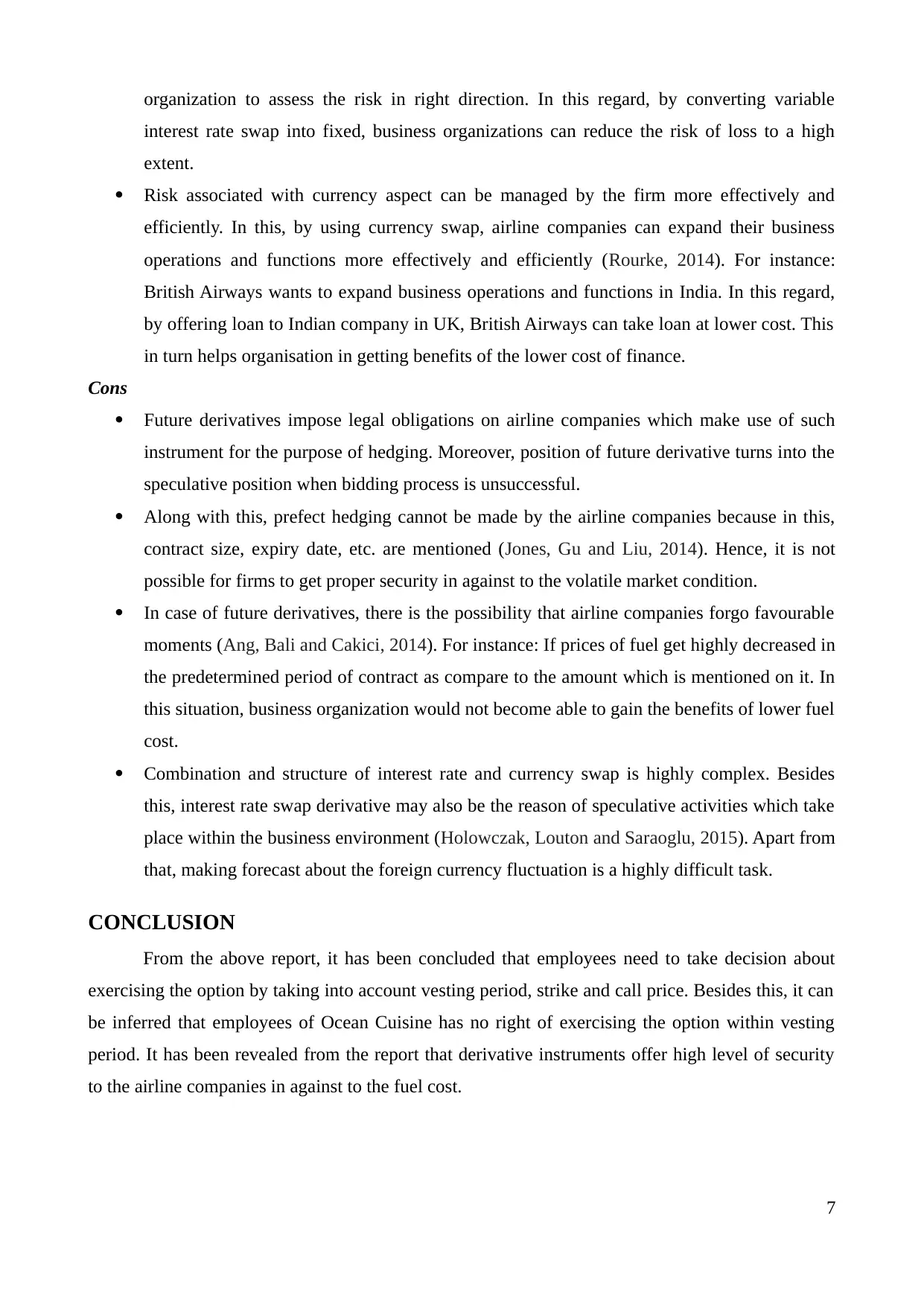
organization to assess the risk in right direction. In this regard, by converting variable
interest rate swap into fixed, business organizations can reduce the risk of loss to a high
extent.
Risk associated with currency aspect can be managed by the firm more effectively and
efficiently. In this, by using currency swap, airline companies can expand their business
operations and functions more effectively and efficiently (Rourke, 2014). For instance:
British Airways wants to expand business operations and functions in India. In this regard,
by offering loan to Indian company in UK, British Airways can take loan at lower cost. This
in turn helps organisation in getting benefits of the lower cost of finance.
Cons
Future derivatives impose legal obligations on airline companies which make use of such
instrument for the purpose of hedging. Moreover, position of future derivative turns into the
speculative position when bidding process is unsuccessful.
Along with this, prefect hedging cannot be made by the airline companies because in this,
contract size, expiry date, etc. are mentioned (Jones, Gu and Liu, 2014). Hence, it is not
possible for firms to get proper security in against to the volatile market condition.
In case of future derivatives, there is the possibility that airline companies forgo favourable
moments (Ang, Bali and Cakici, 2014). For instance: If prices of fuel get highly decreased in
the predetermined period of contract as compare to the amount which is mentioned on it. In
this situation, business organization would not become able to gain the benefits of lower fuel
cost.
Combination and structure of interest rate and currency swap is highly complex. Besides
this, interest rate swap derivative may also be the reason of speculative activities which take
place within the business environment (Holowczak, Louton and Saraoglu, 2015). Apart from
that, making forecast about the foreign currency fluctuation is a highly difficult task.
CONCLUSION
From the above report, it has been concluded that employees need to take decision about
exercising the option by taking into account vesting period, strike and call price. Besides this, it can
be inferred that employees of Ocean Cuisine has no right of exercising the option within vesting
period. It has been revealed from the report that derivative instruments offer high level of security
to the airline companies in against to the fuel cost.
7
interest rate swap into fixed, business organizations can reduce the risk of loss to a high
extent.
Risk associated with currency aspect can be managed by the firm more effectively and
efficiently. In this, by using currency swap, airline companies can expand their business
operations and functions more effectively and efficiently (Rourke, 2014). For instance:
British Airways wants to expand business operations and functions in India. In this regard,
by offering loan to Indian company in UK, British Airways can take loan at lower cost. This
in turn helps organisation in getting benefits of the lower cost of finance.
Cons
Future derivatives impose legal obligations on airline companies which make use of such
instrument for the purpose of hedging. Moreover, position of future derivative turns into the
speculative position when bidding process is unsuccessful.
Along with this, prefect hedging cannot be made by the airline companies because in this,
contract size, expiry date, etc. are mentioned (Jones, Gu and Liu, 2014). Hence, it is not
possible for firms to get proper security in against to the volatile market condition.
In case of future derivatives, there is the possibility that airline companies forgo favourable
moments (Ang, Bali and Cakici, 2014). For instance: If prices of fuel get highly decreased in
the predetermined period of contract as compare to the amount which is mentioned on it. In
this situation, business organization would not become able to gain the benefits of lower fuel
cost.
Combination and structure of interest rate and currency swap is highly complex. Besides
this, interest rate swap derivative may also be the reason of speculative activities which take
place within the business environment (Holowczak, Louton and Saraoglu, 2015). Apart from
that, making forecast about the foreign currency fluctuation is a highly difficult task.
CONCLUSION
From the above report, it has been concluded that employees need to take decision about
exercising the option by taking into account vesting period, strike and call price. Besides this, it can
be inferred that employees of Ocean Cuisine has no right of exercising the option within vesting
period. It has been revealed from the report that derivative instruments offer high level of security
to the airline companies in against to the fuel cost.
7
Paraphrase This Document
Need a fresh take? Get an instant paraphrase of this document with our AI Paraphraser
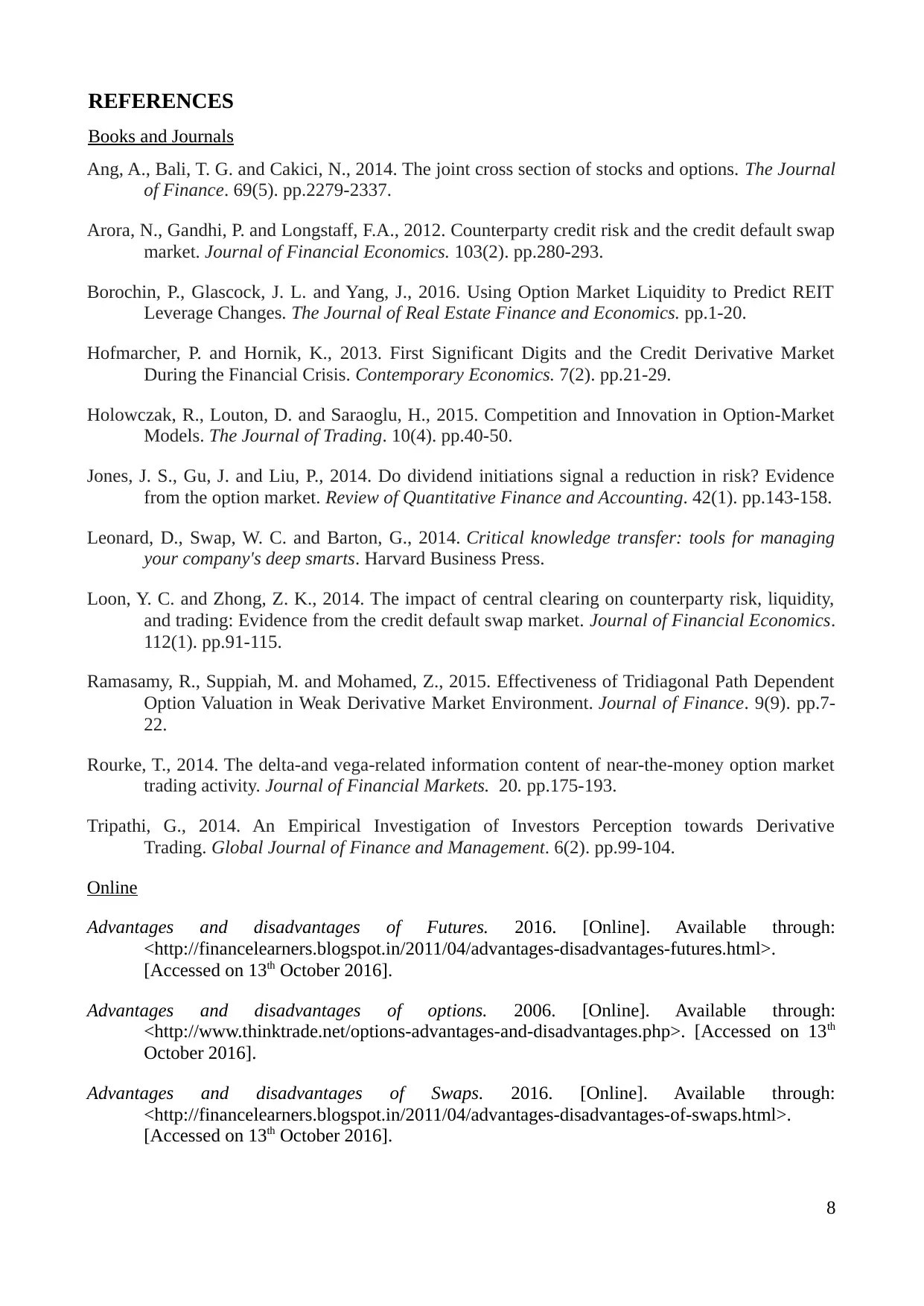
REFERENCES
Books and Journals
Ang, A., Bali, T. G. and Cakici, N., 2014. The joint cross section of stocks and options. The Journal
of Finance. 69(5). pp.2279-2337.
Arora, N., Gandhi, P. and Longstaff, F.A., 2012. Counterparty credit risk and the credit default swap
market. Journal of Financial Economics. 103(2). pp.280-293.
Borochin, P., Glascock, J. L. and Yang, J., 2016. Using Option Market Liquidity to Predict REIT
Leverage Changes. The Journal of Real Estate Finance and Economics. pp.1-20.
Hofmarcher, P. and Hornik, K., 2013. First Significant Digits and the Credit Derivative Market
During the Financial Crisis. Contemporary Economics. 7(2). pp.21-29.
Holowczak, R., Louton, D. and Saraoglu, H., 2015. Competition and Innovation in Option-Market
Models. The Journal of Trading. 10(4). pp.40-50.
Jones, J. S., Gu, J. and Liu, P., 2014. Do dividend initiations signal a reduction in risk? Evidence
from the option market. Review of Quantitative Finance and Accounting. 42(1). pp.143-158.
Leonard, D., Swap, W. C. and Barton, G., 2014. Critical knowledge transfer: tools for managing
your company's deep smarts. Harvard Business Press.
Loon, Y. C. and Zhong, Z. K., 2014. The impact of central clearing on counterparty risk, liquidity,
and trading: Evidence from the credit default swap market. Journal of Financial Economics.
112(1). pp.91-115.
Ramasamy, R., Suppiah, M. and Mohamed, Z., 2015. Effectiveness of Tridiagonal Path Dependent
Option Valuation in Weak Derivative Market Environment. Journal of Finance. 9(9). pp.7-
22.
Rourke, T., 2014. The delta-and vega-related information content of near-the-money option market
trading activity. Journal of Financial Markets. 20. pp.175-193.
Tripathi, G., 2014. An Empirical Investigation of Investors Perception towards Derivative
Trading. Global Journal of Finance and Management. 6(2). pp.99-104.
Online
Advantages and disadvantages of Futures. 2016. [Online]. Available through:
<http://financelearners.blogspot.in/2011/04/advantages-disadvantages-futures.html>.
[Accessed on 13th October 2016].
Advantages and disadvantages of options. 2006. [Online]. Available through:
<http://www.thinktrade.net/options-advantages-and-disadvantages.php>. [Accessed on 13th
October 2016].
Advantages and disadvantages of Swaps. 2016. [Online]. Available through:
<http://financelearners.blogspot.in/2011/04/advantages-disadvantages-of-swaps.html>.
[Accessed on 13th October 2016].
8
Books and Journals
Ang, A., Bali, T. G. and Cakici, N., 2014. The joint cross section of stocks and options. The Journal
of Finance. 69(5). pp.2279-2337.
Arora, N., Gandhi, P. and Longstaff, F.A., 2012. Counterparty credit risk and the credit default swap
market. Journal of Financial Economics. 103(2). pp.280-293.
Borochin, P., Glascock, J. L. and Yang, J., 2016. Using Option Market Liquidity to Predict REIT
Leverage Changes. The Journal of Real Estate Finance and Economics. pp.1-20.
Hofmarcher, P. and Hornik, K., 2013. First Significant Digits and the Credit Derivative Market
During the Financial Crisis. Contemporary Economics. 7(2). pp.21-29.
Holowczak, R., Louton, D. and Saraoglu, H., 2015. Competition and Innovation in Option-Market
Models. The Journal of Trading. 10(4). pp.40-50.
Jones, J. S., Gu, J. and Liu, P., 2014. Do dividend initiations signal a reduction in risk? Evidence
from the option market. Review of Quantitative Finance and Accounting. 42(1). pp.143-158.
Leonard, D., Swap, W. C. and Barton, G., 2014. Critical knowledge transfer: tools for managing
your company's deep smarts. Harvard Business Press.
Loon, Y. C. and Zhong, Z. K., 2014. The impact of central clearing on counterparty risk, liquidity,
and trading: Evidence from the credit default swap market. Journal of Financial Economics.
112(1). pp.91-115.
Ramasamy, R., Suppiah, M. and Mohamed, Z., 2015. Effectiveness of Tridiagonal Path Dependent
Option Valuation in Weak Derivative Market Environment. Journal of Finance. 9(9). pp.7-
22.
Rourke, T., 2014. The delta-and vega-related information content of near-the-money option market
trading activity. Journal of Financial Markets. 20. pp.175-193.
Tripathi, G., 2014. An Empirical Investigation of Investors Perception towards Derivative
Trading. Global Journal of Finance and Management. 6(2). pp.99-104.
Online
Advantages and disadvantages of Futures. 2016. [Online]. Available through:
<http://financelearners.blogspot.in/2011/04/advantages-disadvantages-futures.html>.
[Accessed on 13th October 2016].
Advantages and disadvantages of options. 2006. [Online]. Available through:
<http://www.thinktrade.net/options-advantages-and-disadvantages.php>. [Accessed on 13th
October 2016].
Advantages and disadvantages of Swaps. 2016. [Online]. Available through:
<http://financelearners.blogspot.in/2011/04/advantages-disadvantages-of-swaps.html>.
[Accessed on 13th October 2016].
8
1 out of 8
Related Documents
Your All-in-One AI-Powered Toolkit for Academic Success.
+13062052269
info@desklib.com
Available 24*7 on WhatsApp / Email
![[object Object]](/_next/static/media/star-bottom.7253800d.svg)
Unlock your academic potential
Copyright © 2020–2025 A2Z Services. All Rights Reserved. Developed and managed by ZUCOL.





